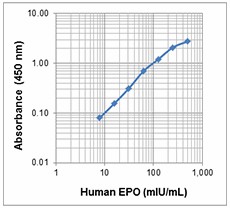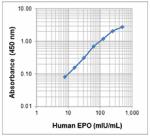- Clone
- M038G10 (See other available formats)
- Regulatory Status
- RUO
- Other Names
- Hematopoietin
- Isotype
- Mouse IgG2b, λ
- Ave. Rating
- Submit a Review
- Product Citations
- publications

Erythropoietin (EPO) is the most important hormone regulating erythropoiesis. It is a glycoprotein also known as hematopoietin. Human EPO is mainly produced in the kidney and liver in response to hypoxia to induce red blood cell synthesis. EPO is a secreted protein of 166 amino acids with a predicted molecular mass of approximately 18 kD. However, it migrates on SDS-PAGE at about 35-55 kD due to heavy glycosylation. Human EPO is closely related to thrombopoietin (TPO), sharing 44% amino acid homology. EPO is highly conserved across species, with human EPO being 80% identical to mouse, and mouse EPO being 95% identical to rat.
EPO functions by binding to its receptor, EPO R, a homodimer, on erythoid precursors, and promotes their differentiation and maturation. As expected, serum levels of EPO are elevated in response to various conditions that result in tissue hypoxia (e.g. blood loss, exposure to high altitude, cardiac or pulmonary disease, and anemia). Increased EPO levels can also be due to increased production by cancer cells of the liver and kidney. Decreased levels of EPO are often seen with chronic renal failure and other chronic diseases or chemotherapy, which cause anemia. Human endogenous EPO and recombinant EPO share the same amino acid sequence, with differences in the glycosylation profiles.
Product DetailsProduct Details
- Verified Reactivity
- Human
- Antibody Type
- Monoclonal
- Host Species
- Mouse
- Immunogen
- In-house recombinant mouse EPO.
- Formulation
- Phosphate-buffered solution, pH 7.2, containing 0.09% sodium azide.
- Preparation
- The antibody was purified by affinity chromatography and conjugated with biotin under optimal conditions.
- Concentration
- 0.5 mg/mL
- Storage & Handling
- The antibody solution should be stored undiluted between 2°C and 8°C. Do not freeze.
- Application
-
ELISA Detection - Quality tested
- Recommended Usage
-
Each lot of this antibody is quality control tested by ELISA. For ELISA detection applications, a concentration of 0.5 µg/mL is recommended. To obtain a linear standard curve, serial dilutions of EPO recombinant protein ranging from 500 to 7.81 mIU/mL is recommended for each ELISA plate.
It is recommended that the reagent be titrated for optimal performance for each application.
- Application Notes
-
ELISA Detection: The biotinylated M038G10 antibody is useful as a detection antibody for a sandwich ELISA assay, when used in conjunction with purified M0312E3 (Cat. No. 662202) antibody as the capture antibody.
Note: For testing human EPO in cell culture supernatant, serum, plasma (heparin, EDTA and citrate), urine, and other biological fluids, BioLegend's LEGEND MAX™ Kits (Cat. No. 442907 & 442908) are specially developed and recommended.
- RRID
-
AB_2650709 (BioLegend Cat. No. 502704)
Antigen Details
- Biology Area
- Immunology
- Molecular Family
- Cytokines/Chemokines
- Gene ID
- 2056 View all products for this Gene ID
- UniProt
- View information about EPO on UniProt.org
Related FAQs
- How many biotin molecules are per antibody structure?
- We don't routinely measure the number of biotins with our antibody products but the number of biotin molecules range from 3-6 molecules per antibody.
Other Formats
View All EPO Reagents Request Custom Conjugation| Description | Clone | Applications |
|---|---|---|
| Biotin anti-human EPO | M038G10 | ELISA Detection |
Compare Data Across All Formats
This data display is provided for general comparisons between formats.
Your actual data may vary due to variations in samples, target cells, instruments and their settings, staining conditions, and other factors.
If you need assistance with selecting the best format contact our expert technical support team.














Follow Us